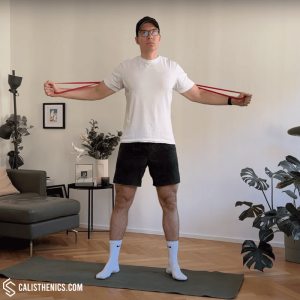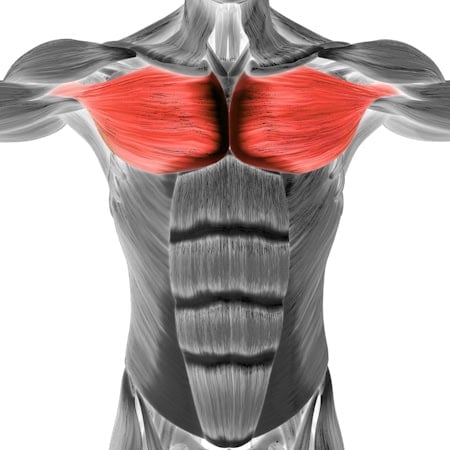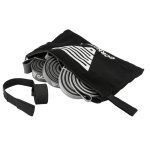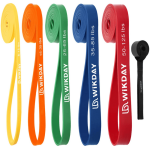Resistance Band Chest Flyes - Unanchored
How to do Resistance Band Chest Flyes - Unanchored?
Description & Steps to Perform the Exercise
Resistance band chest flyes (without an anchor) provide an effective way to target the chest muscles by looping the band around your upper back and holding each end in your hands. This version allows you to perform the chest fly without needing an anchor point, making it ideal for home workouts or when traveling. The movement isolates the chest muscles, while the resistance band adds continuous tension, promoting strength and muscle definition in the chest, shoulders, and arms.
Steps to Perform a Proper Resistance Band Chest Fly (No Anchor):
1. Loop the Resistance Band Around Your Upper Back:
• Place the resistance band across your upper back, just below your shoulder blades, ensuring it stays securely in place.
• Hold one end of the band in each hand with your arms extended out to the sides, keeping a slight bend in your elbows.
2. Set Up in a Staggered Standing Position:
• Stand with one foot slightly in front of the other for balance, knees slightly bent.
• Position your arms out to the sides at shoulder level, with palms facing forward and elbows slightly bent, creating tension in the band.
3. Bring Your Arms Together in Front of Your Chest:
• Exhale as you bring your arms together in front of your chest, squeezing your chest muscles as you draw your hands toward each other.
• Keep your elbows slightly bent throughout the movement, mimicking a “hugging” motion.
• Your hands should meet in front of your chest, with palms facing each other at the end of the movement.
4. Return to the Starting Position:
• Inhale as you slowly open your arms, returning them to the starting position with control.
• Keep the band under tension throughout the return to prevent it from snapping back.
5. Repeat the Movement:
• Perform the desired number of repetitions, focusing on smooth, controlled movements to maintain constant tension in the chest.
Benefits of Resistance Band Chest Flyes (No Anchor)
• Targets Chest Muscles Effectively: This exercise isolates and strengthens the chest, helping build muscle tone and endurance.
• Improves Shoulder Stability: Holding the arms extended during the fly motion engages the shoulder stabilizers, promoting better shoulder health.
• Enhances Muscle Control: The band’s resistance encourages controlled movement, improving the mind-muscle connection with the chest.
• Joint-Friendly Resistance: The band provides a smooth, continuous resistance, making it gentle on the joints and accessible for people with shoulder sensitivities.
• Portable and Convenient: With no anchor point required, this exercise is perfect for home workouts or travel, providing a practical alternative to dumbbell or cable flyes.
• Increases Range of Motion and Flexibility: Chest flyes can help improve flexibility and mobility in the chest and shoulders, supporting better posture and movement patterns.
• Accessible for All Fitness Levels: Resistance bands come in various strengths, making this exercise adaptable for beginners and advanced users.
Common Mistakes to Avoid
• Locking the Elbows: Keep a slight bend in your elbows to protect your joints and ensure proper muscle engagement.
• Using Momentum: Perform the movement slowly, focusing on controlled movement to keep tension in the chest and avoid swinging.
• Allowing the Band to Snap Back: Control the band as you return to the starting position, avoiding any sudden release of tension.
• Leaning Forward or Backward: Engage your core to maintain an upright position and prevent unnecessary stress on the lower back.
• Incomplete Range of Motion: Bring your arms fully together in front of your chest, unless modifying for an easier version, to maximize chest engagement.
Tips for the proper execution of Resistance Band Chest Flyes - Unanchored
Keep Elbows Slightly Bent: Avoid fully extending or locking your elbows to protect your joints and maintain tension in the chest.
Engage the Core: Keep your core tight to prevent arching your back, helping to stabilize your torso and improve posture.
Focus on the Chest Squeeze: Concentrate on squeezing your chest as your hands come together to maximize muscle activation.
Controlled Movement: Move slowly and avoid using momentum; focus on a controlled return to the starting position to keep constant tension.
Breathe Steadily: Exhale as you bring your arms together, and inhale as you open them back, maintaining a steady rhythm.
Muscles worked when doing Resistance Band Chest Flyes - Unanchored
Primary Muscles:
•Pectorals (Chest): The main muscle worked, with a focus on the sternal (middle) portion of the chest.
Secondary Muscles:
•Anterior Deltoids (Front Shoulders): Assist in moving the arms forward, especially during the initial phase of the movement.
•Biceps: Engage slightly to stabilize the arms and support the fly motion.
•Core: Engages to stabilize the torso and prevent any swaying or leaning.
Primary Muscle(s):
Secondary Muscle(s):
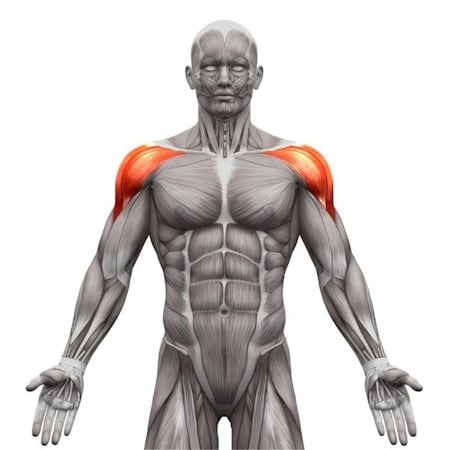
Anterior delt
Adjust the difficulty of Resistance Band Chest Flyes - Unanchored
How to make Resistance Band Chest Flyes - Unanchored harder?
How to make Resistance Band Chest Flyes - Unanchored easier?
How to make Resistance Band Chest Flyes - Unanchored harder?
To make Resistance Band Chest Flyes - Unanchored harder:
-
Use a Heavier Resistance Band: Increase the challenge by using a band with more resistance, requiring greater chest activation.
-
Add a Hold at Full Contraction: Pause for 2-3 seconds when your hands meet in front of your chest to increase time under tension.
-
Slow Down the Eccentric Phase: Take extra time to return to the starting position, focusing on control and engaging the muscles during the eccentric (lengthening) phase.
-
Increase Repetitions or Sets: Perform additional repetitions or sets to build endurance and further challenge the chest muscles.
How to make Resistance Band Chest Flyes - Unanchored easier?
To make Resistance Band Chest Flyes - Unanchored easier:
-
Use a Lighter Resistance Band: Start with a band that provides less resistance, allowing you to perform the movement with better control.
-
Limit Range of Motion: Bring your arms only partway together instead of fully crossing them, reducing the intensity on the chest.
-
Decrease Repetitions: Begin with fewer repetitions (e.g., 8-10) and gradually increase as you build strength in the chest.

